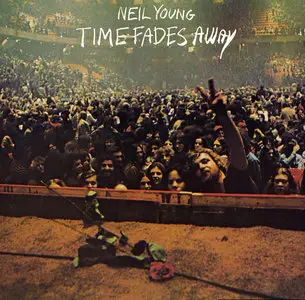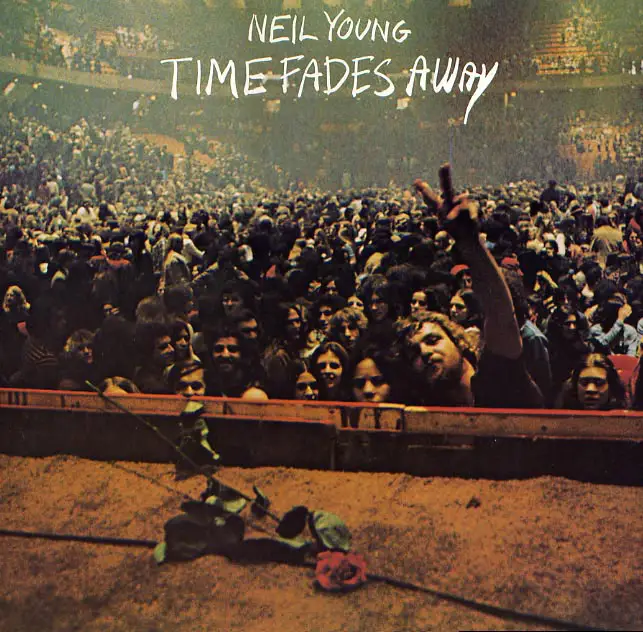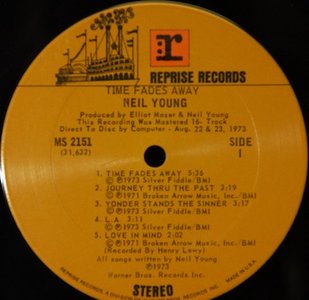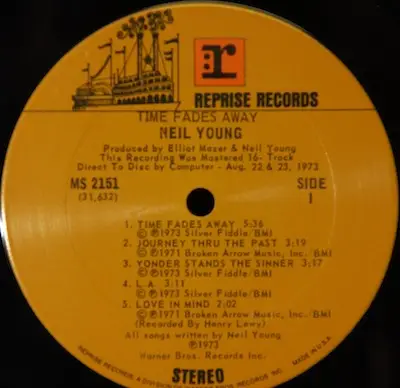Neil Young - Time Fades Away (1973)
Vinyl rip @ 24/96 | FLAC | Artwork | 748Mb
Rapidshare/Hotfile | Rock | 1973 US Reprise 1st pressing direct-to-disc cut/ MS 2151
Vinyl rip @ 24/96 | FLAC | Artwork | 748Mb
Rapidshare/Hotfile | Rock | 1973 US Reprise 1st pressing direct-to-disc cut/ MS 2151
History of the album:
––––––––––-
Originally released on Reprise Records LP; MS 2151, mastered by Phil Brown at Warner Brothers.
Time Fades Away (TFA) is a 1973 live album by Neil Young & The Stray Gators, consisting of previously unreleased material. It was recorded on one of the tours supporting 1972's highly successful 'Harvest'. TFA has not been reissued on CD although it received much critical praise on release, there remains no plan to reissue the album. It has been widely bootlegged, although original vinyl copies are really not too hard to find.
The material on TFA consists of live recordings, each song taken from a different date on a 62 date tour in early 1973. The tour was a total catastrophe, featuring poor audience response to unknown tunes, band members falling out with each other or dropping out of the tour altogether, Young's own crumbling mental state and various other screw-ups that threatened to curtail the whole thing. Somehow, despite everything, the tour finished and the album was released at the end of the year.
Although it sold over a million copies, and critics and fans have since labelled it a success, Neil Young himself is often quoted as saying it's the worst thing he ever did. Valuable, as he puts it, only as a historical document of his turmoil and suffering at the time. A perfect 'how not to do it'. His verdict is probably heavily coloured by the events and memories of the tour itself, but also because events prior to the tour had a profound effect on Young's state of mind, including the death of good friend Danny Whitten (Crazy Horse guitarist) just before the tour began. Young's behaviour on the tour itself was often erratic and sullen, he even gave up his trademark Gibson Les Paul for a Gibson 'Flying V' which really isn't his kind of instrument at all… TFA marks the start of Young's 'angry' period consisting of three notoriously hard to love albums; TFA, On The Beach and culminating with 'Tonight's The Night'.
Without the benefit of any background information, the casual listener would probably describe TFA as unremarkable except for a surly menace underpinning most of the lyrics. In particular 'LA' bristles with a positively evisceral menace in the lyrics which is hard to pick up if you just listen to the music. Elsewhere we are told stories of emotional fuck-ups, harsh life lessons, the corruption of the music industry and so on. It's not an 'easy' ride. Musically the album just about holds together. Although the interface between the audience and the band barely comes across, on the solo songs where Young accompanies himself on piano, the atmosphere is more intimate and personal but no less strained. In fact the more you know about this album the harder it is to feel good about it… but Neil Young fans are well used to his moods and will forgive him every time. It is a mark of his raw talent that this album holds together as well as it does. And all this coming just over a year after his hugely successful 'Harvest' album!
TFA remains one of the two albums in Young's back catalogue that has yet to be given a digital reissue (along with 'Journey Through The Past'). 'Journey…' is unlikely to see the light of day because most of the tracks have already appeared in the first 'Archives' box and several other tunes are tied up in legal wrangles. In 1995, TFA was remastered to the HDCD format for a release that year… but it was shelved at Young's request. Bootleg copies have circulated widely enough for most fans.
Audio notes:
––––––
The technical production methods for TFA differed from any other previous or subsequent album that I know of.
The field recordings were made on 16 track analogue tape recorders but these multi-tracks were not mixed down in the normal way, i.e. to a two-track analogue master tape. Instead Young insisted on using a previously unknown digital mixdown unit known as the 'Quad-8 Compumix' (referred to disparagingly by album producer David Briggs as the 'Compuf*ck') which was used to channel the 16 track recordings through its computer controlled board, direct to the cutting lathe 'live', producing a kind of ad hoc 'direct to disk' style pressing. It didn't 'digitize' the sound, it just 'remembered' mixes on a time-line and recreated the analogue mixdown in real time, for each pass. This kind of automation is pretty much standard today, but unheard of in 1973.
Cutting engineer Phil Brown on the mastering process:
"No two-track master tapes exist of this album. There are the somewhat indifferent Dolby copies we would make while cutting discs for file and tape duping but that's it. Just the 16 track tapes that we cut from and all that was automated was fader level. We used our chambers for echo and used some board EQ and things like that. It could be remixed and could maybe come out better but not the same." Each subsequent cut was in theory the same, because the Compumix settings were left untouched, though there may be differences in the individual cuts that have yet to emerge, I don't know, all I can say is that for this rip, the pressing used was the first available and carried the hand-etched matrix numbers ending in 'RE-2A'. Brown also states that the multi-track tapes were probably compromised in some way by each pass-through, because the machine they used was 'hard on tapes'.
In the normal course of events, the mixing engineer would have the time to carefully choose and apply whatever tweaking or refinements might best suit the final 2-track master but with this method they only had one pass-through with minimal use of effects or any other treatment. The resulting sound didn't really match the trends of the day and sounds quite different from its contemporaries: less 'treated', and you could argue, more accurate.
Track listing:
(Side one)
1. "Time Fades Away" – 5:36
Recorded at The Myriad, Oklahoma City (March 1, 1973)
2. "Journey Through the Past" – 3:19
Recorded at Public Hall, Cleveland (February 11, 1973)
3. "Yonder Stands the Sinner" – 3:17
Recorded at Seattle Center Coliseum, Seattle (March 17, 1973)
4. "L.A." – 3:11
Recorded at The Myriad, Oklahoma City (March 1, 1973)
5. "Love in Mind" – 1:58
Recorded at Royce Hall, UCLA (January 30, 1971)
(Side two)
6. "Don't Be Denied" – 5:18
Recorded at Memorial Auditorium, Phoenix (March 28, 1973)
7. "The Bridge" – 3:05
Recorded at Memorial Auditorium, Sacramento (April 1, 1973)
8. "Last Dance" – 8:45
Recorded at Sports Arena, San Diego (March 29, 1973
The Stray Gators:
Neil Young – lead guitar, piano, harmonica, vocals
Ben Keith – pedal steel, harmony vocals (on tracks 1, 3, 4, 6, 8)
Jack Nitzsche – piano (on tracks 1, 3, 4, 6, 8)
Johnny Barbata – drums (on tracks 1, 3, 4, 6, 8)
Tim Drummond – bass (on tracks 1, 3, 6, 8)
Joe Yankee – bass (on track 4)(Joe Yankee is a pseudonym of Neil Young)
David Crosby – rhythm guitar, backing vocals (on tracks 3, 6, 8)
Graham Nash – rhythm guitar, backing vocals (on tracks 3, 6, 8)
Many thanks to the original ripper: 'Euripides'
Media:
Near mint original US pressing, confirmed 1st edition with hand etched matrix numbers ending in 'RE-2A' mastered by Phil Brown.
It's important to note that the album was made in an unusual way and true fidelity only comes from the first few pressings (see extensive notes in the 'Album Info' text file).
Audio Equipment:
Vpi HW-17F Record Cleaning Machine,
Mains voltage cleaner and spike protection.
Technics SL 1210 Mk II turntable,
Origin Live! modified Rega RB300 Tone Arm,
Denon DL 304 M/C Cartridge,
NAD 3130 Amplifier (Phono Stage Only),
M-Audio Profire 610 Outboard A/D sampling at 96Khz/32bit.
Measured S/N ratio for this system is -87 dB
Audio processing:
Vinyl:
All recording and processing took place in Adobe Audition 3.0 using Adobe's native tools and my own custom scripting.
The LP was very quiet in the quiet passages, and very punchy in the loud sections. For the most part it played superbly but there were several glitches where adjoining grooves affected each other, briefly, for example on high energy vocal sections on 'Last Dance'. I have attempted to hide these and I think the results are clean enough not to be audible but may have affected the sound at those tiny sections treated this way. It wasn't a persistent problem though, and shouldn't be noticeable.
I used very careful manual declicking where necessary for the clearance of stray ticks and clicks, although these were minimal I did a thorough inspection for small clicks because I wish to convey the album rather than the medium :P
The only problem which required a more serious approach was groove roar (low frequency modulation caused by slight manufacturing flaws resulting in uneven groove walls) It was quite intrusive in the very quiet sections. I have faded it from and to mono using a noise footprint sloped from 200 - <100 HZ. Some of the very low frequency sound stage will have been affected but only on quiet passages and fades.
I Normalized across whole 'sides' to 100% maintaining zero clipping before splitting tracks.
NB: I note that several rippers make a point of not normalizing, but with 24 bit audio you'd need to change the volume of a track many times before you'll do any harm, and doing it once as a last step is perfectly safe.
NO Hard limiting. I never use it on audiophile rips.
The download:
The Winrar Archive 'nytfa9624':
FLAC files @ 96Khz/24 bit resolution,
Artwork for the purposes of building your own DVD-Audio disc and printing a CD case insert.
Text files of notes and info.
Synopsis:
The vinyl was in near mint condition and played well, the recordings themselves are for the most part very raw 'real' live music and, when played at an agreeably loud volume can really give the impression of 'being there'. Neil's voice is reassuringly solid in the sound-stage and some of the playing is pretty good… though it could be argued this album is for Neil Young fans only, it is a genuine MUST HAVE if you are a fan.
Hopefully I've presented it as faithfully as possible, but you be the judge. Please enjoy responsibly!
Big thanks again go to Son-of-Albion for posting this for me. If you like this rip, please let him know. Much more to come.
Euripides Jan 2011
Near mint original US pressing, confirmed 1st edition with hand etched matrix numbers ending in 'RE-2A' mastered by Phil Brown.
It's important to note that the album was made in an unusual way and true fidelity only comes from the first few pressings (see extensive notes in the 'Album Info' text file).
Audio Equipment:
Vpi HW-17F Record Cleaning Machine,
Mains voltage cleaner and spike protection.
Technics SL 1210 Mk II turntable,
Origin Live! modified Rega RB300 Tone Arm,
Denon DL 304 M/C Cartridge,
NAD 3130 Amplifier (Phono Stage Only),
M-Audio Profire 610 Outboard A/D sampling at 96Khz/32bit.
Measured S/N ratio for this system is -87 dB
Audio processing:
Vinyl:
All recording and processing took place in Adobe Audition 3.0 using Adobe's native tools and my own custom scripting.
The LP was very quiet in the quiet passages, and very punchy in the loud sections. For the most part it played superbly but there were several glitches where adjoining grooves affected each other, briefly, for example on high energy vocal sections on 'Last Dance'. I have attempted to hide these and I think the results are clean enough not to be audible but may have affected the sound at those tiny sections treated this way. It wasn't a persistent problem though, and shouldn't be noticeable.
I used very careful manual declicking where necessary for the clearance of stray ticks and clicks, although these were minimal I did a thorough inspection for small clicks because I wish to convey the album rather than the medium :P
The only problem which required a more serious approach was groove roar (low frequency modulation caused by slight manufacturing flaws resulting in uneven groove walls) It was quite intrusive in the very quiet sections. I have faded it from and to mono using a noise footprint sloped from 200 - <100 HZ. Some of the very low frequency sound stage will have been affected but only on quiet passages and fades.
I Normalized across whole 'sides' to 100% maintaining zero clipping before splitting tracks.
NB: I note that several rippers make a point of not normalizing, but with 24 bit audio you'd need to change the volume of a track many times before you'll do any harm, and doing it once as a last step is perfectly safe.
NO Hard limiting. I never use it on audiophile rips.
The download:
The Winrar Archive 'nytfa9624':
FLAC files @ 96Khz/24 bit resolution,
Artwork for the purposes of building your own DVD-Audio disc and printing a CD case insert.
Text files of notes and info.
Synopsis:
The vinyl was in near mint condition and played well, the recordings themselves are for the most part very raw 'real' live music and, when played at an agreeably loud volume can really give the impression of 'being there'. Neil's voice is reassuringly solid in the sound-stage and some of the playing is pretty good… though it could be argued this album is for Neil Young fans only, it is a genuine MUST HAVE if you are a fan.
Hopefully I've presented it as faithfully as possible, but you be the judge. Please enjoy responsibly!
Big thanks again go to Son-of-Albion for posting this for me. If you like this rip, please let him know. Much more to come.
Euripides Jan 2011





